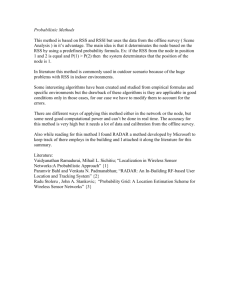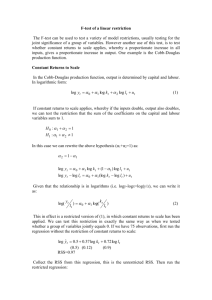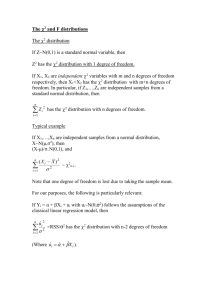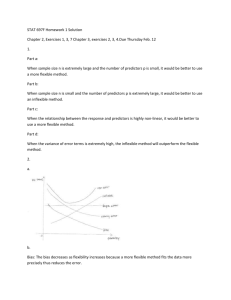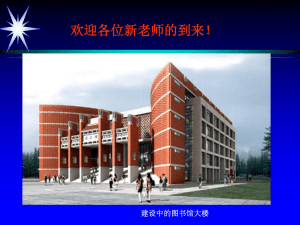Econometrics Notes 4
advertisement
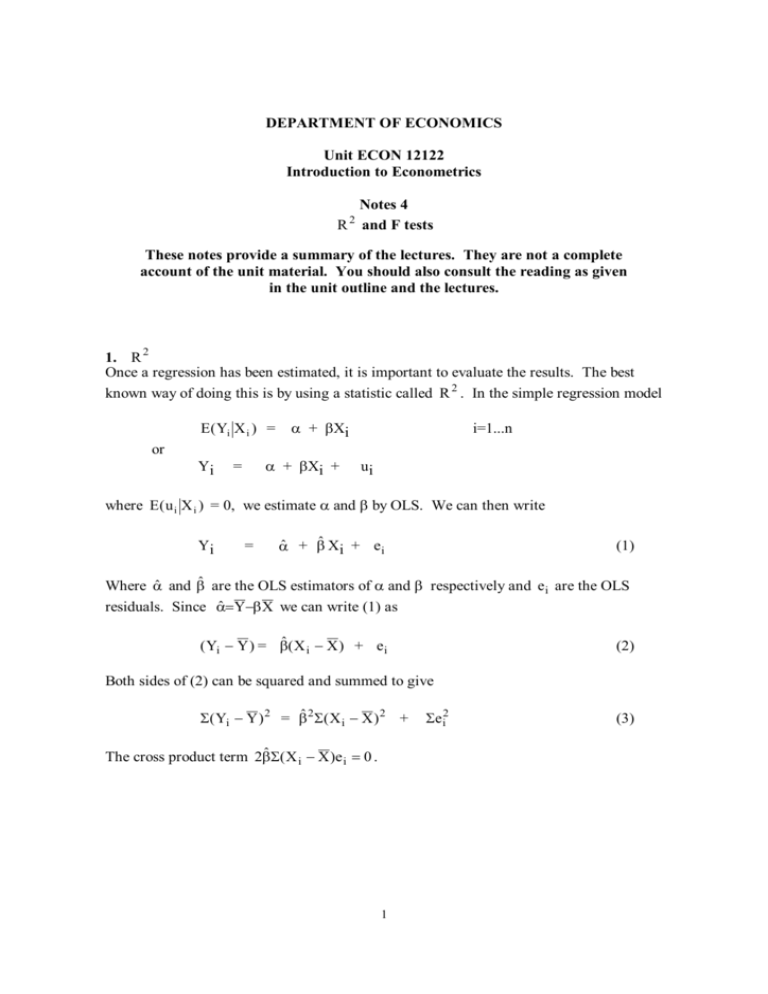
DEPARTMENT OF ECONOMICS Unit ECON 12122 Introduction to Econometrics Notes 4 R and F tests 2 These notes provide a summary of the lectures. They are not a complete account of the unit material. You should also consult the reading as given in the unit outline and the lectures. 1. R 2 Once a regression has been estimated, it is important to evaluate the results. The best known way of doing this is by using a statistic called R 2 . In the simple regression model E( Yi X i ) = or Yi α + βXi α + βXi + = i=1...n ui where E( u i X i ) = 0, we estimate α and β by OLS. We can then write Yi = α̂ + β̂ Xi + e i (1) Where α̂ and β̂ are the OLS estimators of α and β respectively and e i are the OLS residuals. Since αˆ=Y− βX we can write (1) as ( Yi − Y ) = βˆ( X i − X ) + e i (2) Both sides of (2) can be squared and summed to give Σ( Yi − Y ) 2 = βˆ2 Σ( X i − X ) 2 + The cross product term 2βˆΣ( X i − X )e i = 0 . 1 Σe i2 (3) Equation (3) is an important relationship. Each term is referred to as a kind of sum of squares. Σ( Yi − Y ) 2 βˆ2 Σ( X i − X ) 2 Total sum of squares (TSS) Σe i2 Residual sum of squares (RSS) Explained sum of Squares (ESS) Thus (3) says TSS = ESS + R 2 is defined in the following way RSS ESS TSS R2 = Because of (3) 0 ≤ R 2 ≤1 R 2 is often regarded as the “proportion of the variance of the dependent variable which is explained by the regression line”. As such a higher value of R 2 is regarded as better than a lower value. Unfortunately adding spurious explanatory variables to the regression will always raise R 2 when the OLS technique is used to estimate the coefficients. Thus a “high” value of R 2 is not always a good sign. In practice it is often easy to find comparatively high values of R 2 in regressions using time series samples and in this context R 2 is not very informative. Lower values of R 2 generally occur in regressions using large cross-section samples and in this context R 2 is more useful. Although see remarks on “the F test” below. 2. F tests Whenever we wish to test a null hypothesis which contains restrictions on more than one coefficient or consists of more than one linear restriction, a convenient test statistic has the F distribution if the null hypothesis is true. Suppose the model is Yi = α 0 + α1X1i + α 2 X 2i + α 3X 3i + u i examples of such null hypotheses would be (i) α1 = 0, α 2 = 0 or (ii) α1 + α 2 + α 3 = 1 2 i = 1,2,..,n (4) The F test procedure compares the value of RSS under the null (that is when the model is restricted by the null) with the RSS when the model is unrestricted. Thus the restricted model under the null of (i) above would be Yi = α0 + α 3X 3i + u i i = 1,2,..,n The formula for the F test is then ( RSS R − RSS U ) / d RSS U ( n − k ) (5) is distributed as F with d and (n-k) degrees of freedom. Where RSS R is the RSS from the restricted equation RSS U is the RSS from the unrestricted equation d is the number of restrictions n is the number of observations k is the number of coefficients in the unrestricted equation. Thus if the null was as in (i) above d = 2 and k = 4. F tests can be used to test any linear restriction of the coefficients of a regression model. It is important to remember that (5) only has the appropriate F distribution under the null when certain assumptions about the regression model are true. These are (i) The model as described under H 0 is true. (ii) E(uiuj) = σ2 i=j (homoscedasticity) = 0 i≠j (no serial correlation) ( ) (iii) either u i ~ N ο, σ2 or a sufficiently large sample for the central limit theorem to apply. 3. Production Function Example In Notes 2, a Cobb-Douglas production function was estimated on a sample of annual data for UK manufacturing. The OLS results were these yt = 2.776 + 0.284 k t + 0.007 l t (5.030) (0.499) (0.251) + et t = 1,2,..,n (6) standard errors in brackets, n = 24, e t is the regression residual, R 2 = 0.1263, s = 0.0782, RSS = 0.1283, F = 1.518 A number of diagnostic statistics have now been included. 3 R 2 indicates that by the standard of time series regressions, the regression line “explains” a comparatively small proportion of the variation in log output. This is not surprising given the fact the neither slope coefficient is estimated very precisely (both estimated slopes have comparatively large standard errors). s is an estimate of the standard error of the residuals. It is sometimes called the “standard error of the regression”. It is calculated in the following way; s= 2 ∑ et = (n − k ) 2 ∑ et 21 In models where all the variables are measured in logs (as here), s has the interpretation that it is a measure of the size of the average residual as a percentage of the dependent variable. If this regression was used to predict the value of log output over the sample period then the prediction would (on average) be wrong by 7.81 per cent. RSS is the residual sum of squares. It will have a straightforward relationship with s above. You should check that it does so. F is “the F statistic” see section 4 below. Now the reason why we were interested in estimating this Cobb-Douglas production function was to test the hypothesis of constant returns to scale. The model is y = A + α1 k + α 2 l + u Where y = log(Y), A = log( α 0 ), k = log(K), l = log(L) and the random disturbance, u with E(uk,l) = 0 and the hypothesis of constant returns to scale is α1 + α 2 = 1 . This is the sort of hypothesis which the F test is designed for. To calculate the appropriate F statistic we need RSS U and RSS R . We already have the RSS U from equation (6) above (0.1283). We need RSS R . In practice this can often be computed by whatever computer programme we are using. (See Exercise 7). In this example it turns out that RSS R is 0.1339. Note that RSS R is larger than RSS U . If it was not, there would be something wrong with the calculations. We can now compute the F statistic using equation (5) above. F= (0.1339 − 0.1283) / 1 = 0.9166 0.1283 / 21 This F statistic has 1 and 21 degrees of freedom. The critical value of F(1,21) at 95 % is 4.32. Thus we cannot reject the null hypothesis that α1 + α 2 = 1 . As we have seen in 4 Notes 2, the 95 % confidence interval for α1 included one, so it is not perhaps a surprise that we cannot reject the null of constant returns to scale. 4. Tests of Significance. Often when a regression model is estimated, the investigator examines each of the estimated coefficients to see if they are “significant”. This means testing the null hypothesis that the coefficient is zero. The test statistic is βˆ − 0 βˆ = which has a t distribution of (n-k) degrees of freedom. s.e.(βˆ) s.e.(βˆ) This is often called “the t ratio” and is sometimes given in regression results in brackets under the estimated coefficients instead of the standard error. It is important to realize that it can be misleading to focus exclusively on the t ratio. A t ratio may be less than its critical value (and thus the null is not rejected) because the standard error is large even though the point estimate of β ( β̂ ) is also comparatively large. On another occasion the point estimate may be comparatively small (0.002 say) but because the standard error is even smaller, the estimated coefficient may be “significant” (i.e. the null that the coefficient is zero is rejected). If, in the context of the model 0.002 is a very small effect, the fact that this particular coefficient is “significant” may not be very interesting. It is important to remember the that a confidence interval may give more information about the range of possible values of the coefficient than a test of significance. Just as there is “the t ratio” which tests the significance of one coefficient in a regression, so there is “the F test” which tests the significance of all the slope coefficients in the regression. Returning to the example given above, suppose the model is Yi = α 0 + α1X1i + α 2 X 2i + α 3X 3i + u i i = 1,2,..,n (7) We can test the joint null that H 0 : α1 = 0, α 2 = 0, α 3 = 0 against H 1 : any α i ≠ 0 for i = 1,2,3 The test statistic uses the formula (5) above. In this case the RSS U is the RSS from the OLS estimate of the equation (6). The restricted equation takes the form Yi = α 0 + u i i = 1,2,..,n 5 and the RSS from this equation is the TSS from (6). This gives “the F statistic” a particular form which is related to the R 2 from the unrestricted equation. (TSS − RSS U ) /(k − 1) R 2 /( k − 1) “the F statistic” = = RSS U ( n − k ) (1 − R 2 ) /(n − k ) Often “the F statistic” is given as a diagnostic statistic with the regression results. For an example of this see the estimates of the production function, equation (6) above. There “the F statistic” is given as 1.518. This has a distribution of 2 and 21 degrees of freedom. The critical value at 95 % is 3.47. Thus we do not reject the hypothesis that both α1 and α 2 are zero. Again this is not very surprising since the 95% confidence intervals for both these coefficients included zero (see Notes 2). The link between R 2 and “the F statistic” provides a further interpretation to R 2 . If R 2 is comparatively high, it is more likely that the null that all the slope coefficients in the regression are zero will be rejected. If it is comparatively low, then it is more likely that this null will not to be rejected. Notice that “the F statistic” (like all F statistics) depends on the number of observations (n) and the number of coefficients in the model (k). R 2 does not depend on n or k and thus can be artificially boosted as described in section 1 above. The reservations concerning the use of “the t ratio” given above also apply to “the F statistic”. 5. Chow Tests A special and useful application of the F test procedure is to test in time series models for a “structural break”. A structural break is when the coefficients of the model change. Thus suppose we have the following model Yi = α 0 + α1X1i + α 2 X 2i + u i i =1,2,..,T (8) It is believed that the coefficients may have changed at some point in the sample, say after period s. If this were true we would have Yi = β0 + β1X1i + β2 X 2i + u i i =1,2,..,s Yi = γ 0 + γ 1 X1i + γ 2 X 2i + u i i =s+1,..,T Note that the null hypothesis is H 0 : no structural break after observation s. H1 : structural break after observation s 6 and (9) (10) Thus the restricted model is model (8) and the OLS estimates of that model provide RSS R . The unrestricted model is equations (9) and (10). The RSS U is the sum of the RSS for equation (9) and for equation (10). We then apply the formula for the F test as given in (5). In this case it becomes ( RSS R − RSS U ) / k RSS U (T − 2k ) which is distributed as F with k and (T-2k) degrees of freedom. Or in the example above F with 2 and (T-4) degrees of freedom. Note that this test requires that the point s is so placed in the sample that there are enough observations both before and after s for the model to be estimated in each part. If this is not true another form of the test is available (see the textbooks). The test assumes that the variance of the disturbances is the same in both parts of the sample. It is worthwhile checking that the estimates of the variance of the disturbances from each part of the sample are not different by an order of magnitude. If the estimated variances are different by that kind of margin, the Chow test will probably not be valid. 6. Examples of F tests The following estimates were made with a sample of quarterly observations on UK data 1964.1-1991.3. The dependent variables is the log of consumers’expenditure on consumption goods at 1985 prices. y is the log of disposable income at 1985 prices. (I) (ii) (iii) (iv) Constant -0.105 (0.176) -0.149 (0.181) 0.738 (0.514) -1.045 (0.337) Yd t 1.249 (0.143) 1.004 (0.017) 0.946 (0.212) 1.502 (0.186) Yd t − 1 0.185 (0.151) - 0.178 (0.213) -0.604 (0.182) Yd t − 2 -0.434 (0.144) - -0.203 (0.210) -0.603 (0.182) R2 s RSS n 0.973 0.034 0.1237 111 0.971 0.035 0.1335 111 0.890 0.035 0.0564 50 0.951 0.030 0.051 61 Standard errors given in brackets. 7 The model being estimated here can be written c t = a 0 + a1 y t + a 2 y t − 1 + a 3 y t − 2 + u t t=1,2,… ,T where c t is the log of consumers’expenditure at constant prices, y t is the log of disposable income at constant prices. We will use the F test to test two different hypotheses. (i) H 0 : a 2 = 0, a 3 = 0 H 1 : either a 2 ≠ 0 or a 3 ≠ 0 Using the estimates given above RSS U = 0.1237 and RSS R = 0.1335 Thus, F= (0.1335 − 0.1237) / 2 = 4.23 0.1237 / 107 This has an F distribution of 2 and 107 degrees of freedom. The 95% critical value is 3.09 (approximately). Thus we reject the null hypothesis. (ii) Using the estimates given above we can also test for structural change after the 50th observation, that is after 1976.2. H 0 : no structural break after observation 1976.2. H1 : structural break after observation 1976.2. For this test RSS U = 0.0564 + 0.051 = 0.1074 and RSS R = 0.1237 Thus, F= (0.1237 − 0.1074) / 4 = 3.91 0.1074 / 103 This has an F distribution of 4 and 103 degrees of freedom. The 95% critical value is 2.46 (approximately). Thus we reject the null hypothesis that this form of the consumption function did not have a structural break after 1976.2. It is also important to check that the variance of the disturbances did not change at the break point. The estimate of the variance for the first part of the sample is 0.0564/46 = 0.0012. In the second half of the sample it is 0.051/57 = 0.0009. Although these estimates are not identical, they do not indicate that the variance has substantially changed. David Winter March 2000 8


